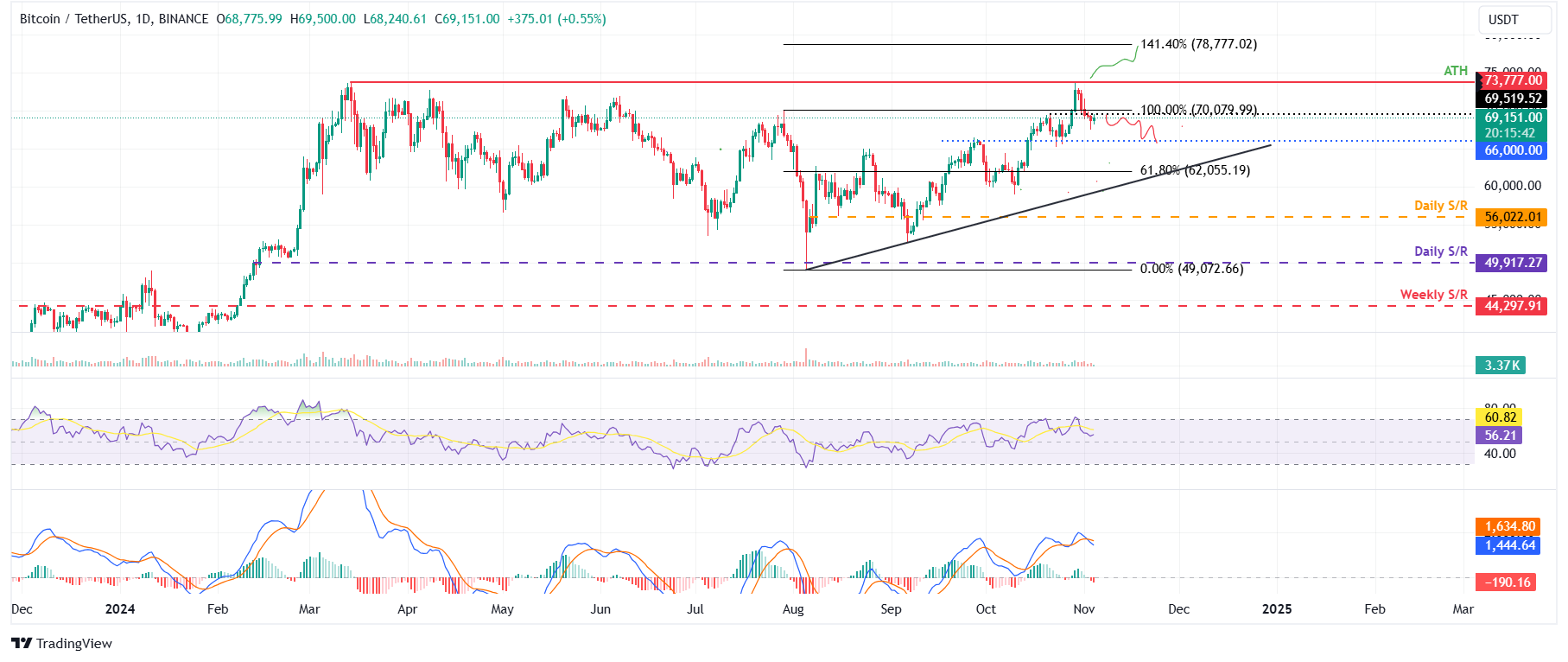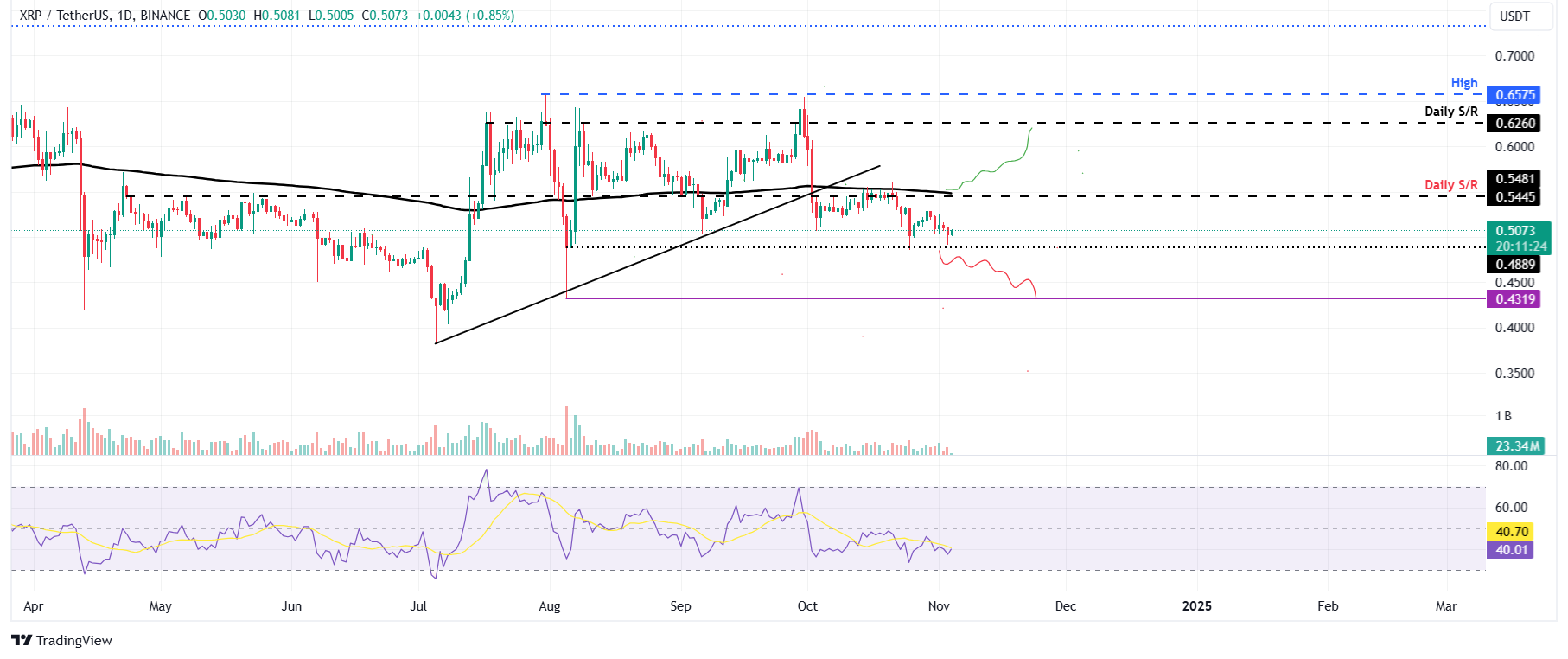Top 3 Price Prediction Bitcoin, Ethereum, Ripple: BTC, ETH and XRP decline ahead of US elections
- Bitcoin shows weakness as it breaks and closes below the $69,500 level.
- Ethereum hovers around the daily support level of $2,419; a sustained close below this mark could trigger a further decline.
- Ripple price is nearing the $0.488 level; a firm close below would suggest a continuation of its downtrend.
Bitcoin (BTC), Ethereum (ETH), and Ripple (XRP) all faced resistance at crucial levels ahead of the US Elections, leading to a price decline. As of Monday, they neared key support levels, and a firm close below these marks could signal further declines.
Bitcoin shows signs of weakness after rejection around its all-time high of $73,777
Bitcoin price faced rejection around its all-time high (ATH) of $73,777 on October 29 and declined 5.44% in the next five days, closing below the $69,500 level on Saturday. At the time of writing on Monday, it trades slightly higher, around $69,150.
If BTC continues to decline, it could crash further to retest its key psychologically important level of $66,000.
The Moving Average Convergence Divergence (MACD) indicator further supports Bitcoin’s decline, signaling a bearish crossover on Sunday's daily chart. The MACD line (blue line) moved below the signal line (yellow line), giving a sell signal. It shows rising red histogram bars below the neutral line zero, also suggesting that Bitcoin’s price could experience downward momentum.

BTC/USDT daily chart
Conversely, if BTC breaks and closes above the $69,500 level, it could rise to retest its ATH level of $73,777.
Ethereum is set for a downturn if it closes below its daily support level of $2,419
Ethereum price hovers around its crucial support level of $2,419 on Monday. This level is important as it roughly coincides with the 50% price retracement level at $2,485, the ascending trendline (drawn from joining multiple low levels with a trendline since early September) and the daily support at $2,419.
If ETH breaks below the ascending trendline and closes below the $2,419 support level, it could extend the decline by 11% to retest its September 6 low of $2,150.
The MACD indicator further supports Ethereum’s decline, signaling a bearish crossover on October 31. The MACD line moved below the signal line, giving a sell signal. Rising red histogram bars below the neutral line zero also suggest that Ethereum’s price could experience downward momentum. Additionally, the RSI on the daily chart reads at 45, below its neutral level of 50, indicating increasing bearish momentum.

ETH/USDT daily chart
However, if the ascending trendline holds as support, ETH could rally to its current level and retest its October 21 high of $2,769.
Ripple is poised for a drop if it closes below the key support level
Ripple price faced resistance around the daily level of $0.544 on October 29 and declined 5% until Sunday. At the time of writing on Monday, it trades slightly higher, around $0.507.
If XRP declines and closes below $0.488, it could extend the decline by 12% to retest its August 5 low of $0.431.
The RSI indicator on the daily chart is at 41, below its neutral level of 50, suggesting that bearish momentum is gaining traction.

XRP/USDT daily chart
On the other hand, if XRP breaks and closes above the 200-day EMA at $0.548, it could extend the rally by 13% and retest its next daily resistance level at $0.626.
Bitcoin, altcoins, stablecoins FAQs
Bitcoin is the largest cryptocurrency by market capitalization, a virtual currency designed to serve as money. This form of payment cannot be controlled by any one person, group, or entity, which eliminates the need for third-party participation during financial transactions.
Altcoins are any cryptocurrency apart from Bitcoin, but some also regard Ethereum as a non-altcoin because it is from these two cryptocurrencies that forking happens. If this is true, then Litecoin is the first altcoin, forked from the Bitcoin protocol and, therefore, an “improved” version of it.
Stablecoins are cryptocurrencies designed to have a stable price, with their value backed by a reserve of the asset it represents. To achieve this, the value of any one stablecoin is pegged to a commodity or financial instrument, such as the US Dollar (USD), with its supply regulated by an algorithm or demand. The main goal of stablecoins is to provide an on/off-ramp for investors willing to trade and invest in cryptocurrencies. Stablecoins also allow investors to store value since cryptocurrencies, in general, are subject to volatility.
Bitcoin dominance is the ratio of Bitcoin's market capitalization to the total market capitalization of all cryptocurrencies combined. It provides a clear picture of Bitcoin’s interest among investors. A high BTC dominance typically happens before and during a bull run, in which investors resort to investing in relatively stable and high market capitalization cryptocurrency like Bitcoin. A drop in BTC dominance usually means that investors are moving their capital and/or profits to altcoins in a quest for higher returns, which usually triggers an explosion of altcoin rallies.



